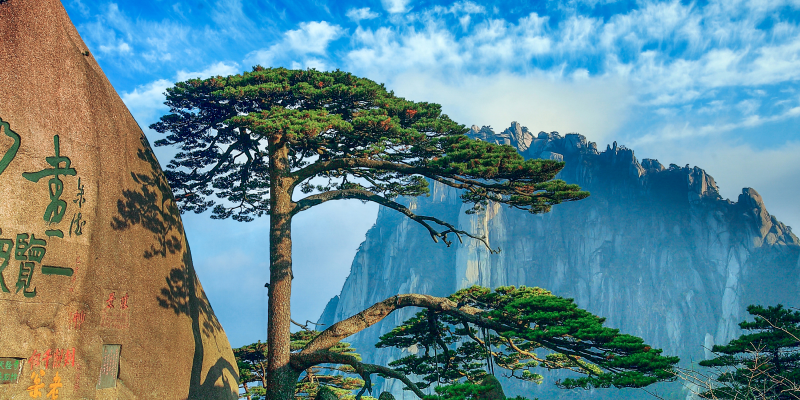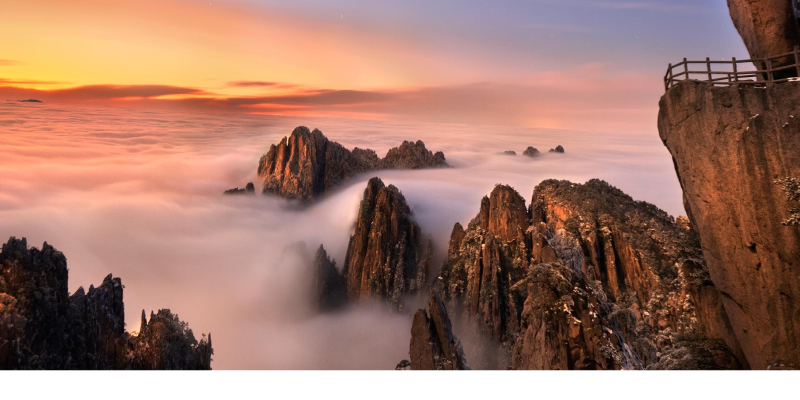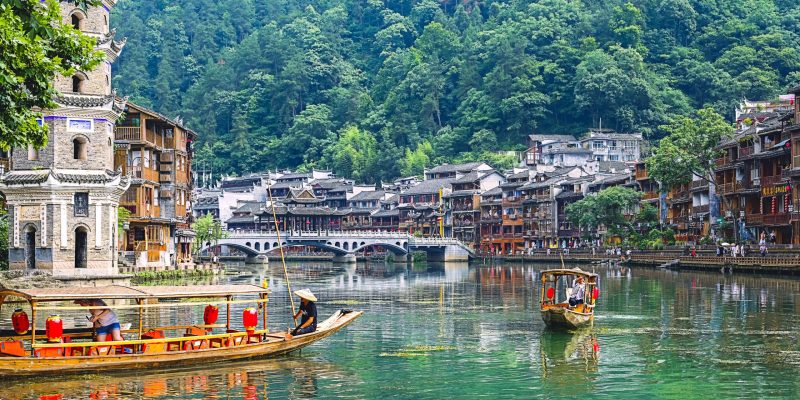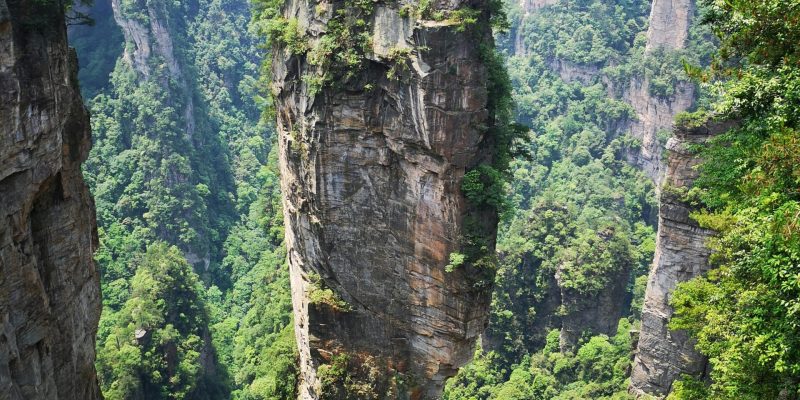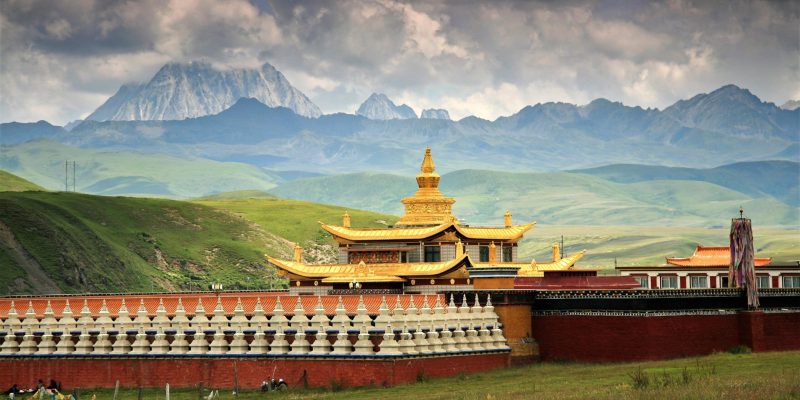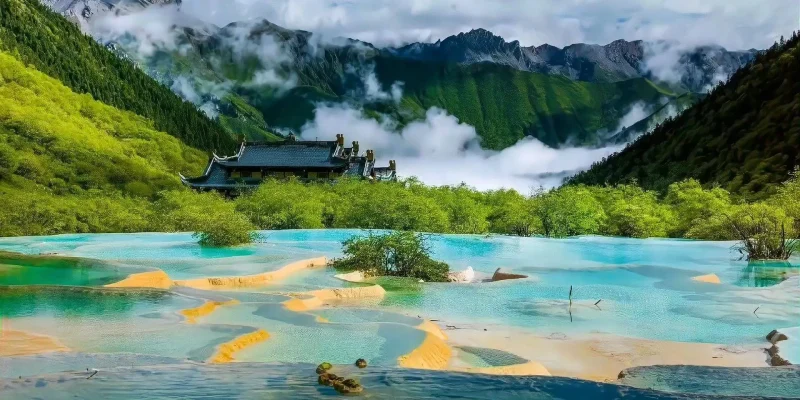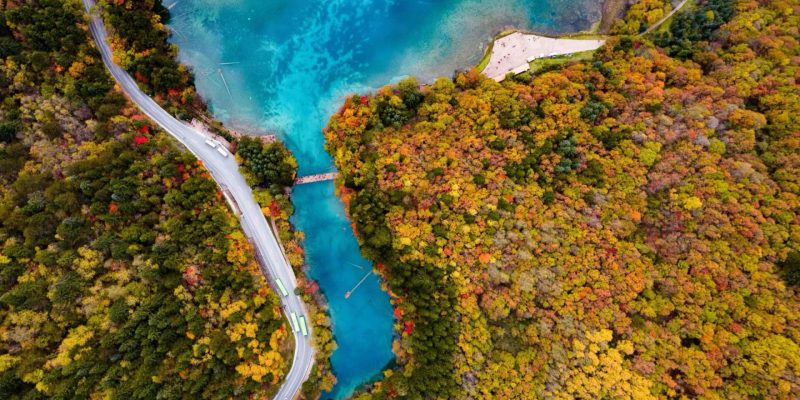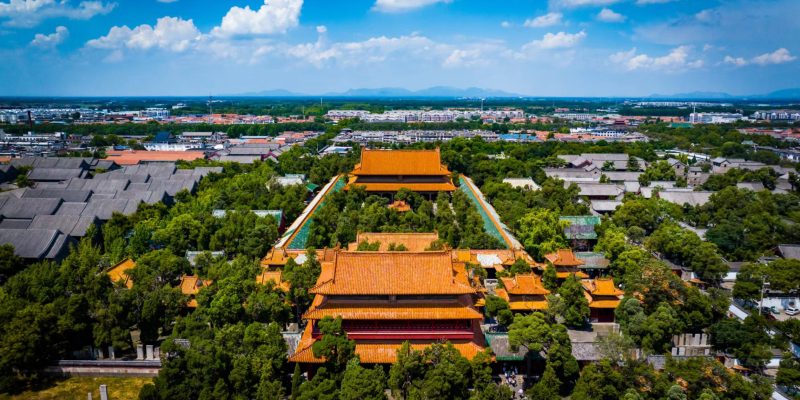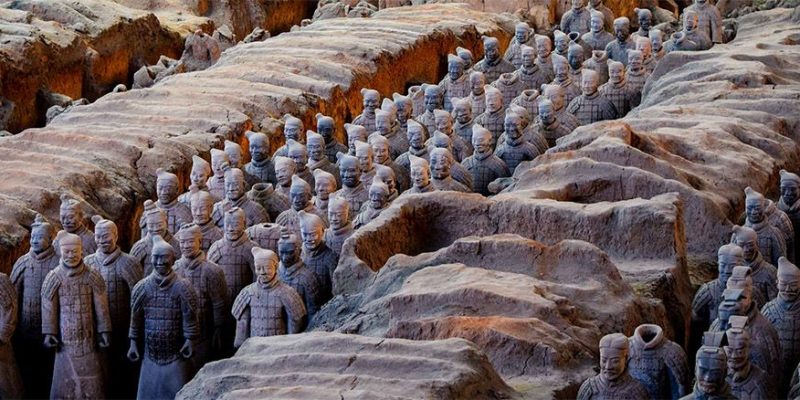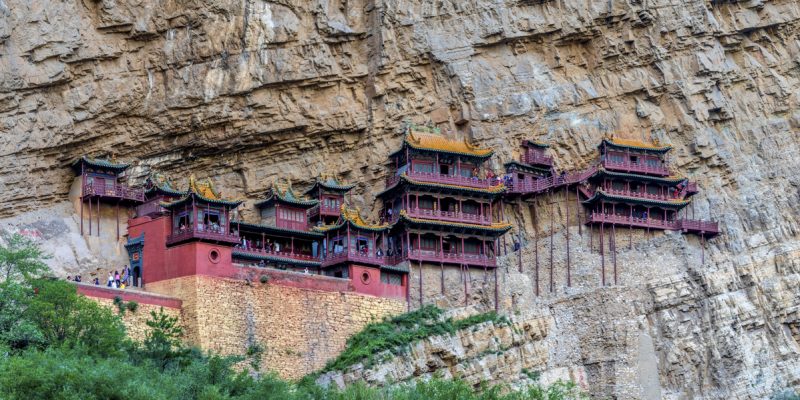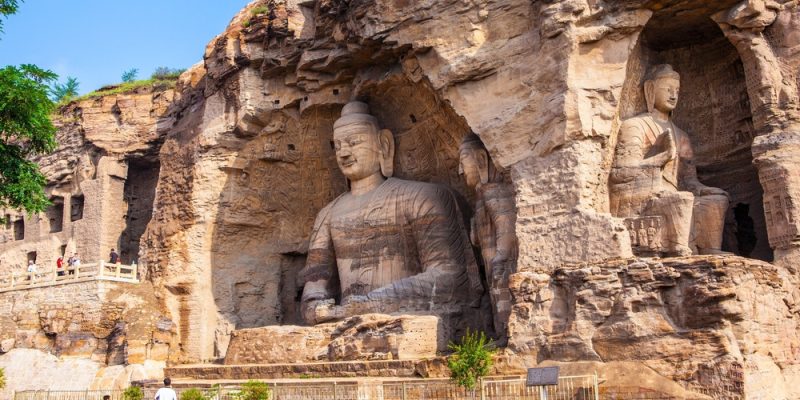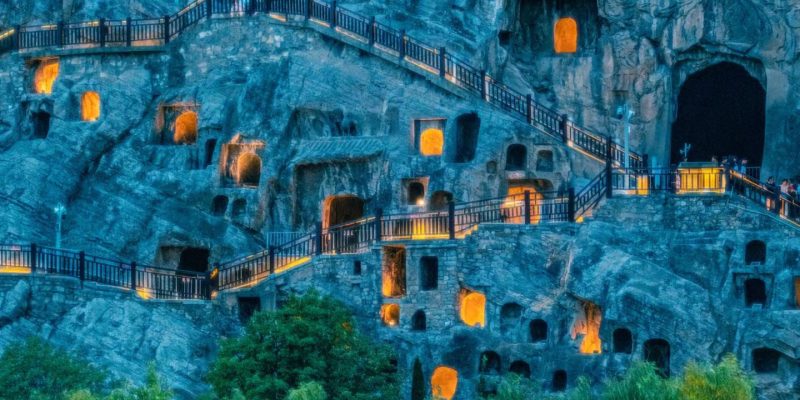Embarking on a journey to China, you’re likely aware that this land is home to a multitude of magnificent mountains ripe for discovery, with landscapes that are unparalleled elsewhere on the globe. As you traverse the summits and dales of these renowned mountains, each step unveils a fresh perspective of this captivating country.
From the shrouded heights of Huangshan to the dramatic escarpments of Zhangjiajie and the revered Five Sacred Mountains (Wu Yue), we present to you the top 10 Chinese mountains worth visiting.
1.Mount Huangshan

The Mount Huangshan
Huangshan Mountain, alternatively known as Mount Huang or Yellow Mountain, is an extraordinary destination for travelers due to its stunning beauty and rich historical significance. Spanning more than 160 square kilometers, the mountain is predominantly composed of granite, which imparts a distinctive and dramatic silhouette against the skyline. Its distinctive granite peaks, venerable pine trees, and the spectacular sea of clouds have earned it the distinction of a UNESCO World Heritage Site.
Location: Huangshan City, Anhui Province
Elevation: 1864 meters (6115 feet)
Key Attractions:
- Granite Peaks: These distinctive granite formations are a dominant feature of the landscape. With a bit of imagination, you might spot peaks and rocks resembling various animals, such as monkeys or dogs.
- Ancient Pine Trees: Among the ten renowned pines, “The Pine Greeting Guests” stands as a prominent symbol, named for its appearance of a figure extending a hand in welcome to visitors.
- Sea of Clouds:A visit to Huangshan wouldn’t be complete without witnessing the awe-inspiring sea of clouds that surround the peaks. The clouds’ movement is akin to waves crashing on a shore, especially magical during sunrise when the scene resembles a vivid painting.
Duration of Visit:
Most tourists allocate 2 to 3 days to fully experience Huangshan Mountain.
- A one-day visit provides a brief overview of the main attractions.
- Two days allow for a more relaxed exploration and the opportunity to hike through the West Sea Valley Grand Canyon or the Front Huangshan Mountain (Jade Screen Scenic Area).
- For a thorough experience and to fully appreciate the mountain’s splendor, a stay of 3 days or more is advised. If time permits, extending the journey to include nearby villages such as Hongcun is recommended.
Best Time to Visit:
Huangshan Mountain is a destination that can be enjoyed all year round, with each season offering unique and picturesque views.
- The optimal times to visit are spring (March to May) and autumn (September to November). These seasons offer mild weather and the mountain is dressed in vivid colors, creating a stunning backdrop. Moreover, the likelihood of experiencing clear skies and the enchanting sea of clouds is higher during these times, which significantly enhances the visit.
Recommended Tour Itinerary
6 Days
"Huangshan, Huangling Village, Qiandao Lake"
2.Zhangjiajie
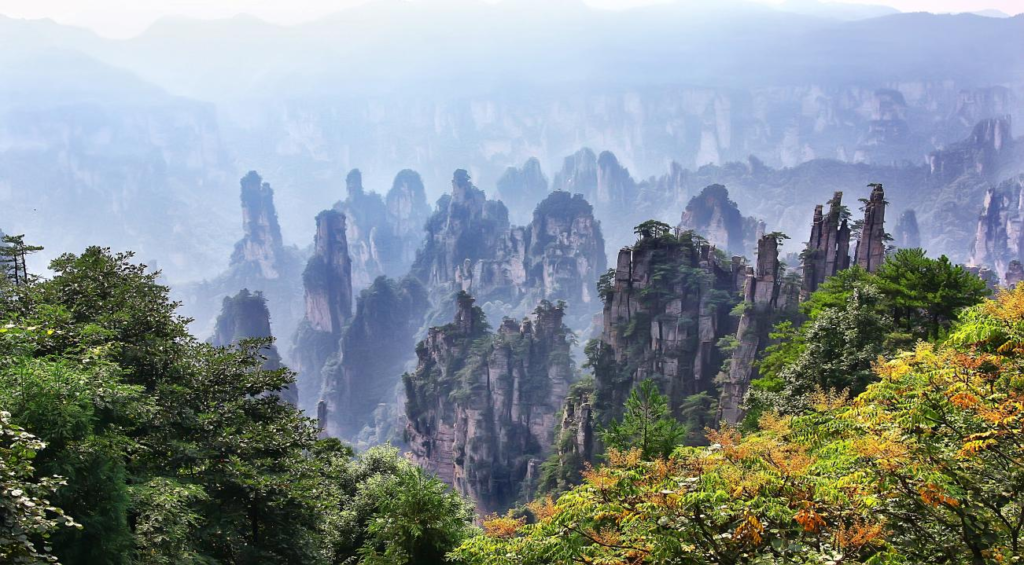
The Quartz-sandstone Pillars Point to the Sky
Zhangjiajie is not merely a mountain but a scenic region characterized by a mountainous landscape, replete with numerous hills and impressive quartz-sandstone columns. From a vantage point at the base, these columns resemble a multitude of swords pointing skyward. It’s reported that Zhangjiajie National Park is home to over 3000 such columns, with 1000 of them exceeding 200 meters in height.
Location: Zhangjiajie City, Hunan Province
Key Attractions:
- Avatar Hallelujah Mountain (Tianzi Mountain): Gaze upon the towering sandstone formations that served as the inspiration for the floating mountains in the film “Avatar.”
- Tianmen Mountain: Ascend the 999-step staircase to reach Tianmen Cave, often referred to as the Heaven’s Gate.
- Golden Whip Stream: Stroll along this scenic stream, surrounded by towering cliffs and lush greenery.
- Zhangjiajie Grand Canyon: Discover the stunning beauty of Zhangjiajie Grand Canyon, famous for its steep cliffs, dense forests, and the thrilling Glass Bridge that spans it.
Duration of Visit:
A visit to Zhangjiajie usually requires about 3 days to explore the key attractions, including Zhangjiajie National Forest Park (with Tianzi Mountains) and the captivating Golden Whip Stream.
For those seeking thrills and adventure, it’s recommended to add a day or two to your itinerary to delve into Tianmen Mountain and to experience the majestic Zhangjiajie Grand Canyon.
Optimal Visiting Periods:
The most favorable seasons to visit Zhangjiajie are spring (from March to June) and autumn (from September to October), when the weather is cool, perfect for hiking, and the views are spectacular.
During July and August, the skies are clear, offering excellent conditions for mountain views, although these months are peak tourist season due to summer holidays. From November to February, there are fewer visitors, which can be ideal for witnessing snowy landscapes and enjoying lower costs, although the weather can be quite cold.
Recommended Tour Itinerary
3.Jade Dragon Snow Mountain

Jade Dragon Snow Mountain
Yulong Snow Mountain, also known as Jade Dragon Snow Mountain, is a must-see attraction for anyone traveling to Yunnan, China. It provides breathtaking panoramas of peaks dusted with snow, dense forests, and pristine lakes.
Location: Lijiang, Yunnan Province
Elevation: 5,596 meters (18,360 feet)
Key Attractions:
- Glacier Park:A thrilling cable car journey takes you to the glaciers’ edge, where, at an altitude of over 4,500 meters, you can tread on the ice and take in the magnificent vistas of the snow-clad peaks.
- Blue Moon Valley: Nestled at the mountain’s foot, this picturesque valley is famed for its azure lakes and transparent streams. The combination of blue waters, verdant surroundings, and snowy caps creates an idyllic setting for photography and hiking.
Suggested Duration:
A one-day excursion is typically sufficient to explore the main attractions of Jade Dragon Snow Mountain, including visits to Glacier Park and Blue Moon Valley.
Ideal Visiting Period:
The optimal period for a visit to Jade Dragon Snow Mountain is from late spring to early autumn, roughly from April to October. The weather during these months is generally pleasant and clear, which is perfect for hiking and enjoying the scenery.
Winter spans from November to March. Although it’s a less busy time due to the colder climate and possible snowfall, it offers a distinctive and peaceful experience with lower costs. Some areas might be inaccessible due to snow, but for those who prefer solitude and a different perspective, it can be a rewarding time to visit.
Recommended Tour Itinerary
3 Days
"Kunming ,Yuanyang Hani Rice Terraces"
4.Mount Everest

Mount Everest
Visiting the north face of Mount Everest from the Tibetan side reveals the majestic visage of Earth’s tallest peak, a sight that fills one with a sense of awe. This encounter with the mountain can make you realize the insignificance of human existence in the grand scheme of the world.
Location: On the border between Nepal and Tibet, China
Elevation: 8,849 meters (29,032 feet)
Key Attractions:
- Everest Base Camp:Here, you can enjoy breathtaking views of the north face of Everest and observe the starting point for climbers. The journey to the camp itself is remarkable, featuring glaciers, snow-covered summits, and the expansive Tibetan Plateau.
- Rongbuk Monastery: Positioned at 5,100 meters (16,730 feet), Rongbuk Monastery is the highest monastery on Earth. It is close to Everest Base Camp and provides breathtaking vistas of the nearby mountaintops.
How Many Days to Spend:
- To visit the North Base Camp and get an intimate view of Mount Everest, you should allocate an additional 2 days to your Tibet trip. If you aim to push your limits by hiking to higher camps, such as the Advanced Base Camp at 6,400 meters (21,000 feet), you might require approximately a week or longer.
When is the Best Time to Visit:
- The optimal seasons for visiting the Tibetan side of Mount Everest are spring (April to June) and autumn (September to early November). These times offer more stable weather and milder temperatures, with clear skies that enhance the beauty of Everest and its neighboring peaks. These periods are also favored by climbers aiming to reach the summit.
Recommended Tour Itinerary
5.Emei Mountain

Emei Mountain,Golden Top
Emei Mountain, a revered Buddhist site in China, boasts a wealth of cultural legacy, breathtaking scenery, and profound spiritual importance. As you climb its well-tended trails, you’ll come across historical temples, verdant woodlands, and a variety of wildlife, including the distinctive Emei Mountain monkeys.
Location: Sichuan Province, Leshan City
Elevation: 3,099 meters (10,167 feet)
Key Attractions:
- Golden Top(Jinding): Perched at an elevation of 3,077 meters, the Golden Summit provides spectacular vistas, particularly during sunrise. On a clear day, you might also witness the mesmerizing cloud sea.
- Baoguo Temple: Serving as the gateway to the Emei Mountain scenic area, Baoguo Temple is a significant cultural landmark, showcasing exquisite architecture and ancient artifacts.
- Wannian Temple: Among the most ancient temples on Emei Mountain, Wannian Temple is home to an impressive bronze statue of Samantabhadra riding a white elephant.
- Qingyin Pavilion: Nestled amidst dense forests and cascading waterfalls, Qingyin Pavilion offers a serene setting to appreciate the natural splendor of Emei Mountain.
How Many Days to Spend:
- A visit to Emei Mountain typically requires 1-2 days if you plan to use the cable car to reach the Golden Summit and visit some key temples. For a more leisurely exploration, including some hiking or a visit to the nearby Leshan Giant Buddha, 3-4 days are recommended.
When is the Best Time to Visit:
- The optimal seasons for visiting Emei Mountain are spring (March to May) and autumn (September to November), characterized by clear skies and pleasant temperatures.
- Springtime brings blossoming flowers and verdant foliage, while autumn’s vibrant foliage enhances the mountain’s charm. Both seasons are perfect for hiking and immersing oneself in the mountain’s natural beauty.
Recommended Tour Itinerary
3 Days
"Chengdu, Leshan Giant Buddha, Dujiangyan Irrigation System"
7 Days
"Chengdu, Mt Emei, Mt Qingchen, Dujiangyan"
6.Mount Tai
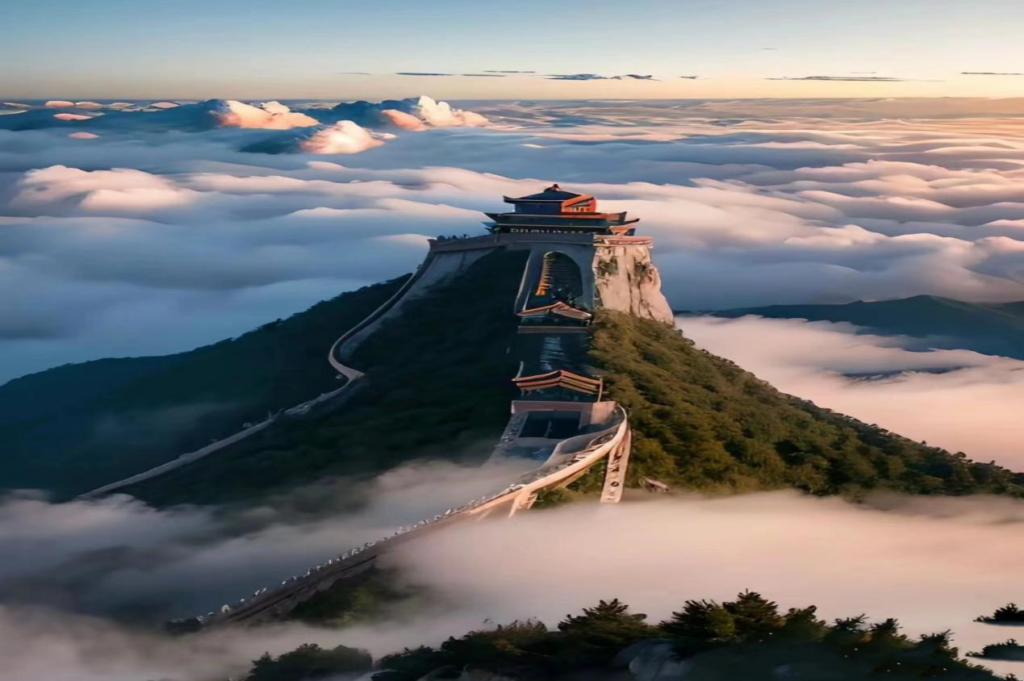
Mount Tai
Mount Tai is revered as the chief of the Five Great Mountains in China. It is surrounded by stunning natural landscapes and has a rich cultural heritage, integrating history and nature.
Throughout history, Mount Tai has been a sacred pilgrimage site for emperors, with 13 making the arduous journey to its summit and 24 sending officials to offer sacrifices. Today, remnants of this rich history adorn the mountain’s slopes, offering glimpses into ancient ceremonies through well-preserved buildings and sculptures.
Location: Tai’an City, Shandong Province (About 80km from Jinan City, the capital of Shandong Province)
Elevation: 1532.7 meters (5029ft.)
Key Attractions:
Jade Emperor Peak: Reach the summit of Mount Tai for panoramic views of the surrounding landscape and to witness the awe-inspiring sunrise.
Dai Temple: Explore this ancient temple complex dedicated to the worship of Mount Tai, featuring ornate architecture and cultural relics.
Bixia Temple: Pay homage to the goddess Bixia Yuanjun, believed to be the protector of Mount Tai, at this sacred temple nestled in the mountains.
Paiyun Pavilion: Admire the traditional Chinese architecture of this pavilion, which offers stunning views of the cloud-filled valleys below.
Nantian Gate: Pass through this historic gate, known as the “South Heaven Gate,” which marks the entrance to the scenic area of Mount Tai.
How Many Days to Spend
Typically, exploring Mount Tai requires 1 to 2 days. Accommodations offer two main choices: one nestled at the mountain’s base and the other perched near its majestic peaks. While lodging at the peak area may incur slightly higher costs, it’s highly recommended for those eager to witness the captivating sunrise vistas.
When is the Best Time to Visit
The best time to visit Mount Tai is during the spring and autumn months, from April to May and September to November, respectively. During these periods, the weather is mild and pleasant, making it ideal for hiking and sightseeing. Especially during the fall, the foliage changes colors, creating breathtaking landscapes.
However, it’s important to note that Mount Tai can get crowded during peak seasons, so planning ahead and booking accommodations in advance is advisable for a smoother and more enjoyable experience.
Recommended Tour Itinerary
6 Days
"Jinan, Mt Tai, Qufu, Qiangdao"
7.Mount Hua

The Track to the Top of Mount Hua
The towering crests of Mount Hua invite daring souls with their fabled precipitousness. Its cliffs, nearly standing on end, call to mind tales of divine axes that cleft them, enhancing the mountain’s enigmatic allure.
The trails of Mount Hua, frequently clinging to the edges of sheer precipices, have secured its reputation as one of the globe’s most hazardous hiking routes.
Furthermore, the abundance of temples and sacred edifices on Mount Hua bear witness to its deep religious importance, rendering it a site imbued with legend, antiquity, and a sense of the sacred.
Location: Shaanxi Province, Weinan City
Elevation: 2154.9 meters (7067 feet)
Key Attractions:
- The Precipitous Pathway: Affixed to a cliff’s side, this slender wooden track is not actually perilous (with safety harnesses in place), yet it undoubtedly offers an adrenaline rush!
- The Five Eminent Peaks: Each summit provides remarkable vistas and distinctive encounters. The West Peak stands as the loftiest, the South Peak is famed for its temples, and the East Peak is the premier spot for witnessing the sunrise.
- The Yellow Temple:Dating to the 7th century, this Taoist temple complex is an excellent venue for delving into the mountain’s historical and cultural narratives.
- The Jade Gateway:This natural rock arch is a favored photo backdrop, presenting awe-inspiring panoramas of the encompassing mountains.
Duration of Visit:
Mount Hua presents a range of adventurous activities based on your schedule. For an exhilarating jaunt, visit the West Peak and the plank path in a single day. Two days allow you to scale all five peaks and the Green Dragon Ridge. For those eager to tread every path and explore every temple and cultural treasure of Huashan Mountain, three or more days are essential.
Optimal Visiting Period:
The most favorable times to explore Mount Huashan are the spring and autumn seasons, from April to June and September to November. These periods are marked by agreeable temperatures and clearer skies, creating perfect conditions for traversing Mount Hua’s rugged landscape and soaking in its spectacular views.
Recommended Tour Itinerary
8.Mount Hengshan (Northern Yue)
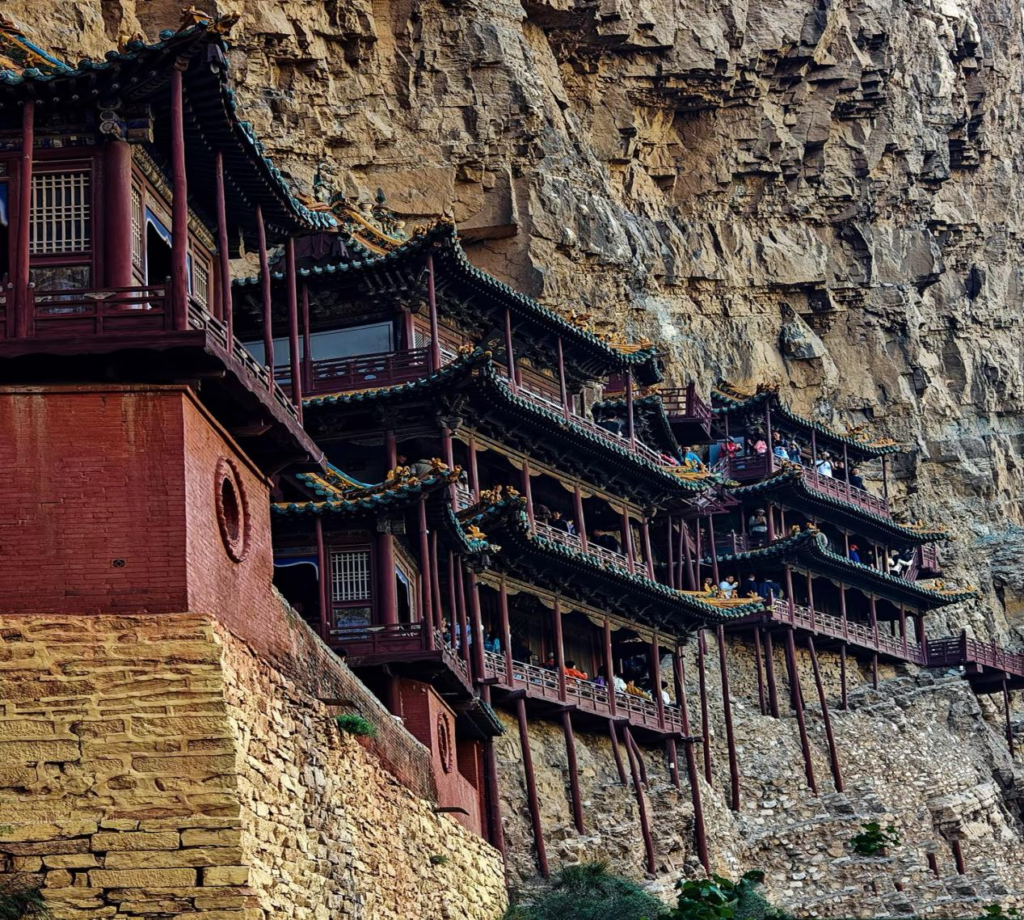
Hanging Temple Hung on the Cliff
Tucked away close to Datong City in Shanxi Province, Hengshan Mountain—distinguished as the North Hengshan to differentiate it from its southern namesake—presents a diverse array of experiences. It caters to history enthusiasts, nature lovers, and those in search of spiritual fulfillment, with something to offer every visitor.
Location: Shanxi Province, Datong City (Approximately 290km from Taiyuan City, Shanxi’s provincial capital)
Elevation: 2016.1 meters (6617 feet)
Key Attractions:
- Hanging Temple:This extraordinary Buddhist temple complex precariously hangs off a cliff, appearing to challenge the laws of gravity. Constructed over 1,500 years ago, its detailed architecture blends Buddhist, Taoist, and Confucian elements. It stands as an engineering wonder and is an essential stop for anyone visiting Hengshan Mountain.Also is a filming locatin for the Large-Scale game Black Myth:Wukong.
- Golden Dragon Gorge: Hengshan’s striking landscape is adorned with captivating geological features. The Golden Dragon Gorge, a slender ravine with steep sides, historically served as a strategic defense location. Venture into hidden grottoes, natural arches, and rock formations that contribute to the mountain’s enigmatic allure.
Duration of Visit:
- Typically, 1-2 days suffices to discover the mountain’s key highlights, such as the Hanging Temple and the Golden Dragon Gorge. However, for those with a deeper interest in its historical and cultural aspects, extending your stay by a few more days is recommended.
Best Time to Visit:
- The spring and autumn seasons provide the most pleasant weather for exploring North Hengshan, with mild temperatures and clear skies that are perfect for appreciating the mountain’s splendor.
- If you’re willing to brave colder weather and possible restricted access, winter can offer a more tranquil experience, surrounded by the mountain’s tranquil beauty.
Recommended Tour Itinerary
9.Mount Heng (Southern Yue)
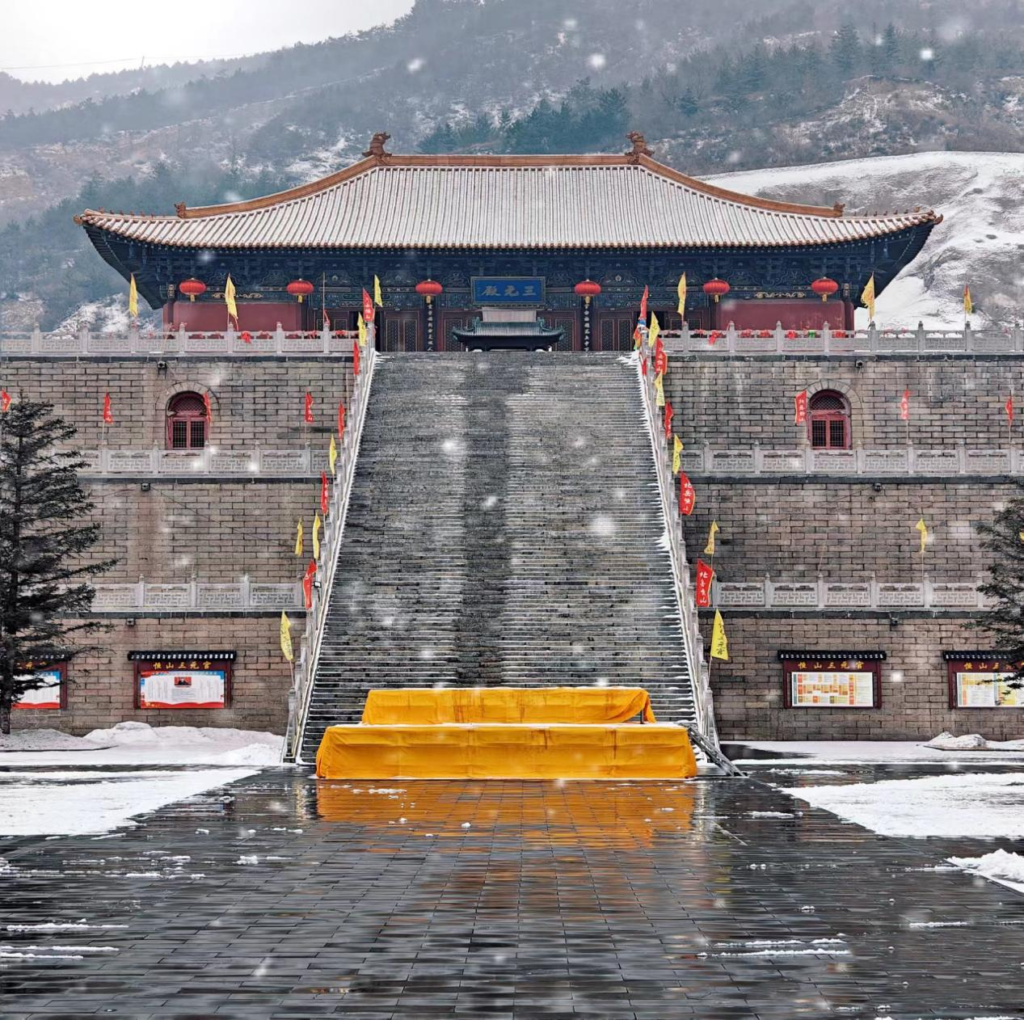
Winter In Hengshan
Spanning a wide region with 72 majestic peaks, Mount Hengshan provides a picturesque retreat for those seeking to hike and immerse in the natural beauty of the landscape. As a significant site for both Buddhism and Taoism for many centuries, it also promises a distinctive cultural and spiritual journey.
Location: Hunan Province, Hengyang City
Elevation: 1300.2 meters (4266 feet)
Key Attractions:
- Grand South Heaven Temple (Nanyue Miao):This extensive temple complex, with roots in the Tang Dynasty (618–907), boasts impressive architecture that includes nine courtyards and a main hall that soars 22 meters high.
- Zhurong Peak: Crowning Hengshan Mountain as its highest point, Zhurong Peak presents unparalleled views. Climbing to its peak rewards with sweeping panoramas, especially during sunrise when clouds often form an enchanting sea of mist. The Zhurong Temple, honoring the Chinese deity of fire, enhances the peak’s mystique.
- Huayan Peak:Renowned for its assembly of temples and monasteries such as Shuanglin Temple and Zhinian Temple, Huayan Peak offers insights into the rich Buddhist and Taoist heritage of Hengshan Mountain.
- Shigu Rock:This geological marvel, shaped like a stone drum, is a favorite spot for capturing photographs.
Suggested Duration:
- To experience a well-rounded visit, 2-3 days is ideal for exploring the temples at Huayan Peak and witnessing the sunrise at Zhurong Peak. For a brief encounter, a day trip to the Grand South Heaven Temple and a mountain hike will suffice. Dedicated hikers and history enthusiasts may opt for 4+ days to discover secluded trails, temples, and the tranquility of the mountain, possibly even spending a night at a monastery.
Optimal Visiting Period:
- With a subtropical monsoon climate, Hengshan Mountain is best visited during the spring and autumn months when temperatures are pleasantly around 16°C (60.8°F) on average. These seasons are perfect for outdoor activities, while summers can be humid with occasional rain, and winters are dry with light snowfall at higher elevations.
- For those who appreciate verdant scenery, visiting during the rainy season from May to August is advisable. However, be prepared for potential heavy rainfall during this time.
Recommended Tour Itinerary
10.Mount Song
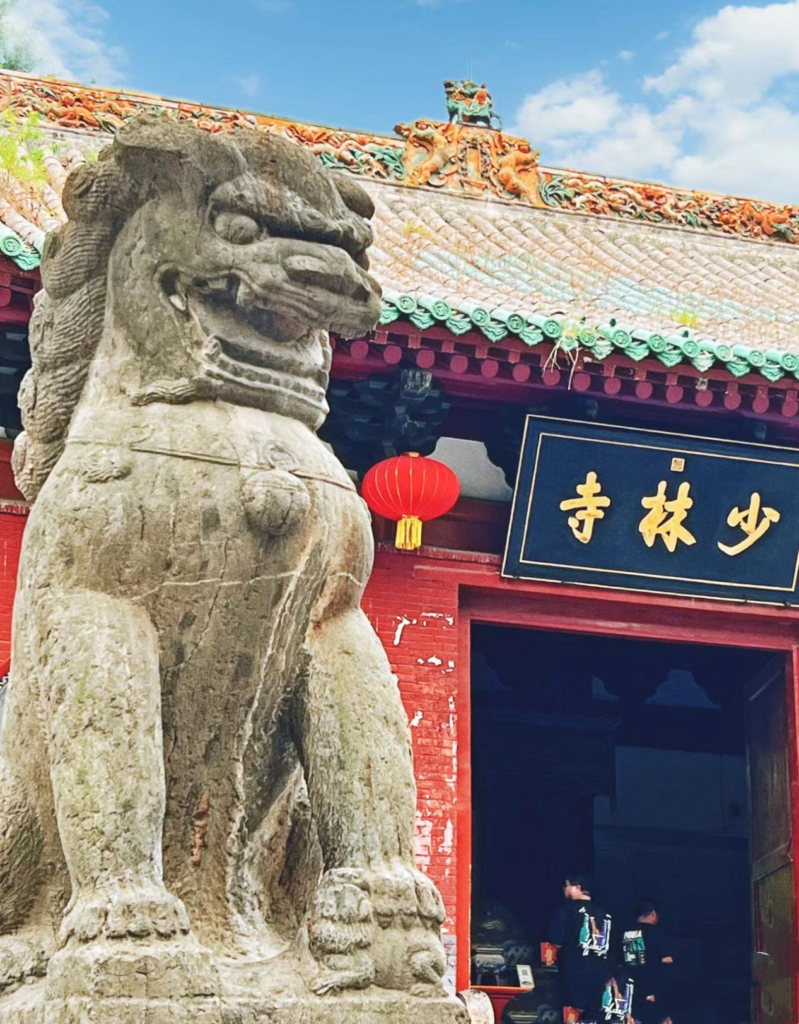
The Gate of Shaolin Temple
Known as the “Central Mountain” due to its position among the Five Great Mountains of China, Mount Song is revered as the birthplace of Chinese civilization. Historically, emperors have come to seek divine favor, while its majestic presence has inspired countless poets and scholars.
A tapestry of history and culture, Mount Song presents a harmonious fusion of stunning natural landscapes and profound spiritual importance. For aficionados of Kung Fu, a visit to Mount Song is an essential pilgrimage within China.
Location: Henan Province, Zhengzhou City
Elevation: 1512 meters (4961 feet)
Key Attractions:
- Shaolin Temple:With a legacy spanning over 1500 years, Shaolin Temple remains the epicenter of Chinese Kung Fu. Experiencing a live Kung Fu demonstration here is an experience that lingers in memory.
- Taishi Peak: As the tallest peak in the Songshan range, Taishi Peak provides demanding treks accompanied by stunning vistas.
- Songyang Academy:Among the four most esteemed Confucian institutions in China, it offers an excellent opportunity to immerse in Chinese cultural learning.
Duration of Visit:
- A half or full day is sufficient to explore the Songshan Mountain. Combining your visit with other Zhengzhou-area attractions, such as the Longmen Grottoes and Luoyang Museum, is highly recommended.
Best Time to Visit:
- Songshan is accessible year-round. For those who prefer cooler temperatures, spring and autumn are more favorable. If your goal is to attend the Shaolin Temple International Martial Arts Festival, plan your visit for late September or early October, though the dates may vary annually.
Recommended Tour Itinerary
8 Days
"Zhengzhou, Anyang, Kaifeng, Dengfeng, Luoyang"
Embark on a Mountain Adventure with Us:
- To arrange a seamless tour of China that includes visits to these majestic mountains, please reach out to us. If you’ve had an extraordinary hiking experience in China, we invite you to share your travel logs or photographs with us.

